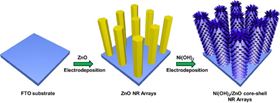 Schematic illustration of the fabrication procedures for Ni(OH)2/ZnO core–shell NR arrays on FTO substrates.
Schematic illustration of the fabrication procedures for Ni(OH)2/ZnO core–shell NR arrays on FTO substrates.Artificial photosynthesis is quite a buzz term at the moment, essentially it refers to any process that captures and stores energy from sunlight. It is of particular interest at the moment as there is heightened interest in any energy storable carbon neutral process.
An example of artificial photosynthesis, photoelectrochemical (PEC) water splitting is becoming a promising technique in solar energy conversion. The technique is currently hampered by performance issues which feature as the main area of interest for scientists looking for efficient clean energy alternatives. Even though research in this field has been ongoing for over 4 decades scientists are still looking for solutions centred around economies of scale, efficiency and stability.
PEC cells use light energy to conduct the chemical reaction of splitting water into its component parts namely hydrogen and oxygen gases. They are made of an anode and cathode immersed in an electrolyte and connected to an external circuit. In many cases the anode or cathode is made up of a semiconductor that absorbs sunlight, and the other electrode in most cases a metal.
For the technique to be successful one of the requirements is to have a high-performance photoanode and research in this area is currently taking place [Mao et al, Nano Energy, 6, (2014), 10-18, DOI: 10.1016/j.nanoen.2014.02.008].
Research developments such as these could significantly change the feasibility of artificial photosynthesis as a viable alternative to our current fossil fuel energy reliance.
Prizes such as the 2014 Resonate Award, which goes to scientists developing solutions for safe and cost effective energy storage solutions can only help drive innovation and solutions over the coming years.
To download the article related to this news story, please click here.